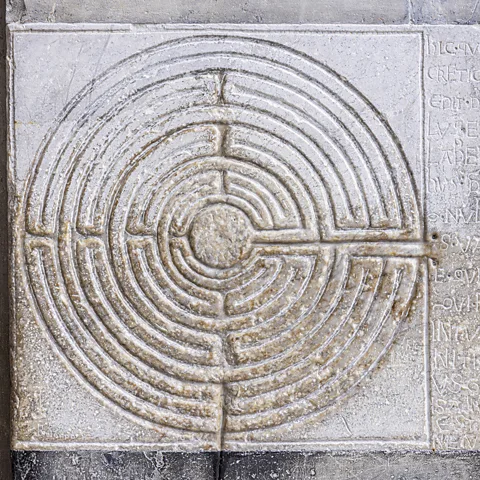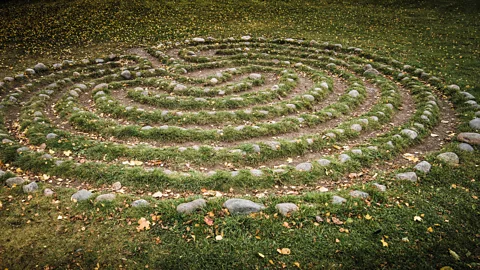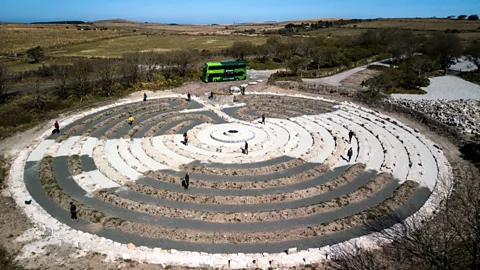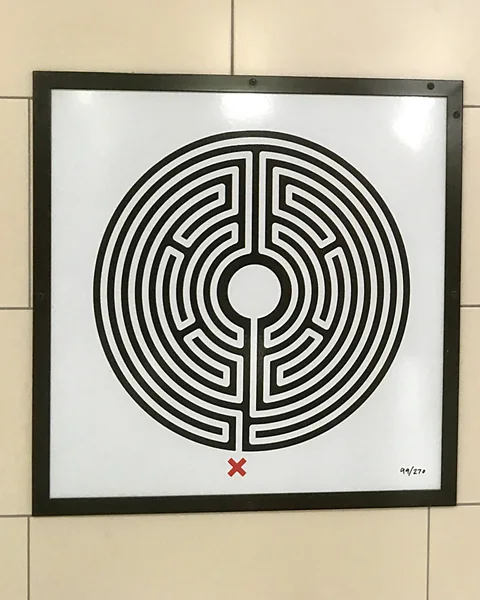Labyrinth walking: Ancient activity that could help ease anxiety
WORLD 09 May 2024 - 22:00
BBC carries an article about walking labyrinths which has become an increasingly popular global method of reducing stress, Caliber.Az reprints the article.
Walking labyrinths has become an increasingly popular global method of reducing stress by integrating the mind and the body.
I'm pacing slowly across gently sloping parkland in a place I didn't know existed until I began to research this article. I've passed this park hundreds of times just a mile from my house in the English coastal city of Brighton & Hove without realising it contained a labyrinth. Created by artist Chris Drury in 2006, it takes inspiration from the complex pattern of a giant 40m-wide fingerprint, marked by stones set flat into the grass. As I focus on following its inward path, I forget the joggers and dog walkers around me and fall into a more contemplative state as I walk the winding 600m-plus route to its centre.
Labyrinths have been used worldwide for centuries as a way to quieten the mind, ease anxiety, recover life balance, enhance creativity and boost insights. During the Middle Ages, nearly 25% of cathedrals had them, and today walking labyrinths has become an increasingly popular global method of promoting anti-stress by integrating the mind and the body.
Don't confuse labyrinths with mazes. Mazes confound people with dead ends and the threat of getting lost. In contrast, labyrinths draw on classical designs that, however complex the route, guarantee an unobstructed progress to and from their centre.
"The labyrinth is a sure path in unpredictable times," says Reverend Dr Lauren Artress, who founded the non-profit organisation Veriditas in 1996 to help "pepper the planet with labyrinths".
Examples of classic labyrinth imagery date back 4,000 years. In Europe and North Africa labyrinth designs appeared in rock carvings and paintings, as well as inscriptions on tiles and coins. Across Asia, the Americas and southern Africa, meanwhile, they were carved on rock or into sand and adorned woven baskets. Alongside these deep historical roots, the practice of labyrinth walking may have another appeal to busy modern folk. "Many people, like myself, have 'failed' at sitting meditation," says Artress. "A walking meditation demands the same inner awareness."

In fact, labyrinth walking has experienced a revival in recent years. Since 2009, the first Saturday in May has seen people across the planet mark World Labyrinth Day by following paths long and short through a vast array of labyrinths that have blossomed worldwide in recent decades.
More notable modern labyrinths
The largest classical labyrinth in the world is Jim Buchanan's 130m diameter Earth and Wild Flower Labyrinth built at Tapton Park in northern England using earth from excavation work.
American land artist Anne Drefahl constructs glistening temporary labyrinths using fresh snow in her native Wisconsin. "Labyrinths ask us to think about our environment on a different scale," she says. "And to slow down while doing it."
The recently completed El Santuario de los Pabladores (Sanctuary of the Settlers) in Colorado – the world's largest hand-made adobe labyrinth – was constructed with more than 40,000 mud bricks.
The Labyrinth Society's Worldwide Labyrinth Locator now lists around 6,400 labyrinths across 90-plus countries.
And labyrinths are being created in settings very different to my local park. "For people in hospitals and prisons, labyrinth walking as a mind-body integrative practice can be life-sustaining and healing in addition to traditional forms of medical treatment or counselling," says Jocelyn Shealy McGee, assistant professor in the Diana R Garland School of Social Work at Baylor University in Texas. "Our research found labyrinth walking can foster a sense of peace and other positive emotions, reduce stress, cultivate self-compassion and connection and provide an opportunity for reflection on one's life and meaning making." This comes through a combination of the sure progress to the heart of the labyrinth, combined with the need to progress slowly and thoughtfully by following the twists and turns built into the pattern.
Myriad forms of historical labyrinths can be found across the globe. Nordic stone versions line the shores of the Baltic Sea, while labyrinth patterns known as Chakra Vyuha ("Spinning Wheel Formation") are inscribed on Indian temple walls. Native American tribal art includes the iconic Tohono O'odham ("Man in the Maze") pattern.

Many labyrinths, however, take design cues from two classic templates. Dating back more than 3,000 years, Cretan labyrinths are named after the Mediterranean island where the formations are said to have originated in Greek mythology, and consist of a single pathway that loops back and forth to form seven circuits (concentric paths) around the centre.
The Chartres pattern, meanwhile, features 11 circuits, and is named after the magnificent French cathedral whose floor holds its most famous example. Labyrinths based on the Chartres design became popular in medieval Europe, in part as a form of mini pilgrimage that was a lot easier – and safer – than heading to Jerusalem or trudging to Santiago de Compostela.
A giant newcomer
My own labyrinth pilgrimage leads to a lakeside amid the wild beauty of Bodmin Moor in England's westernmost county of Cornwall. This is where the Kerdroya labyrinth is nearing completion after several years of work, named after a Cornish word that roughly translates as "castle of turnings". Based on a 56m diameter Cretan pattern, it is being built using a form of dry stone walling known as Cornish hedging. In use for around 4,000 years, the Cornish hedge is among the oldest human-built structures in Britain.
"I pitched the idea 20 years ago but got no traction or funding – so it sat in a dusty drawer," reveals Will Coleman, artistic director of Cornish cultural organisation Golden Tree who are behind both the conception and building of this imposing labyrinth. "Then in 2018, the Cornish Area of Outstanding Natural Beauty put out a call for projects to celebrate the Cornish landscape." And when this stunning piece of "land art" opens to the public this September, it will lay claim to being the largest stone-wall labyrinth in the world. Its construction is also training 60 young Cornish hedgers to help preserve an ancient craft.
Kerdroya's construction in its dramatic location on one of England's wildest moors includes sourcing base stones for its walls from the adjacent lake, where centuries-old submerged Cornish hedging was revealed beneath its surface one recent hot summer. "We weren't allowed industrial machinery on the site, so used horse, sled and human chains to move the stones," says Coleman.

Walking me to what will be the heart of Kerdroya when all the stone hedges are in place, Coleman stands atop a metal plaque that depicts an aerial view of the giant labyrinth to allow visitors to see the path they have followed. The labyrinth will also include an audio trail for visually impaired users. “But it will be very light on interpretation. I'm not telling people what to think – people can make what they like of it. People in future will just enjoy the beautiful shape and the iconic form,” Coleman says.
He also reveals how the labyrinth's ancient Cretan pattern took cues from a labyrinth carved onto riverside rock in the breathtaking Rocky Valley near the historic Cornish hamlet of Tintagel. The Rock Valley carvings are believed to be roughly 300 years old, but Coleman explains that the labyrinth designs mirror a 1,300-year-old template found on rock at Knidos in south-west Turkey. Though I'm standing still with an expansive view over a lake to a vast English moor, my mind is journeying across both time and space.
Finding digital dharma
Historic labyrinths are also inspiring a contemporary trend of so-called "finger labyrinths". These modern takes on ancient rock carvings offer pathways to reflection by creating printed or embossed patterns that users can trace by hand, letting their fingers journey to the heart of the pattern.
Perhaps the most ambitious – and unexpected – example of finger labyrinths are embossed on plaques at 272 stations on the vast London tube network, where the two most recent designs were unveiled in 2023 at the Nine Elms and Battersea Power Station stops. Having found out about their existence just before my trip to Cornwall, I was pleased to come across my first sighting of one by chance at Paddington tube station as I made my way to the Night Riviera overnight sleeper train that provides a wonderfully stress-free way to get to Cornwall from the heart of the capital.
The London underground project was the brainchild of Turner Prize-winning artist Mark Wallinger, working in collaboration with renowned global labyrinth designers Mazescape. One challenge was to make the designs of each station's labyrinth different, to reflect the idea that every journey on the Underground is unique to each person.

To come up with 272 different labyrinth designs, Mazescape delved into a panoply of historic design types. "My personal favourite is the traditional Native American Tohono O'odham pattern," reveals Mazescape designer Angus Mewse. "I like the way the pathway narrows as it proceeds – it gives a sense of increasing drama and intensity as you approach the centre."
The London Underground labyrinths are now providing the basis for a new urban pilgrimage. "We hear regularly via social media from 'Labyrinth-hunters' who travel to each station to capture a photo," reveals Eleanor Pinfield, Head of Art on the Underground.
The creation of new labyrinths in settings ranging from the London Underground to wild moorland is a mark of their deep-rooted ubiquity. So get walking. And don't worry, you won't get lost.
Caliber.Az
|
1
|
700 tunnel shafts found in Rafah, 50 cross into Egypt Israel informs South Africa at UN top court
17 May 2024 - 15:56
|
|
2
|
Uncertainty over Russian border guard withdrawal from Armenia Amid conflicting statements
18 May 2024 - 14:47
|
|
3
|
New Caledonia crisis mirrors Macron's hypocrisy on Azerbaijan France faces its own crisis
17 May 2024 - 17:20
|
|
4
|
Giant meteor seen lighting up skies of Portugal
19 May 2024 - 13:11
|
|
5
|
Iranian president's helicopter makes hard landing on border with Azerbaijan
19 May 2024 - 17:25
|
Pakistan declares national mourning as South Asian leaders condole death of Iran's president
20 May 2024 - 12:56
How France exploits Europe's periphery for profit
Economic colonialism20 May 2024 - 12:49
Iranian president's death to challenge supreme leader succession - ISW
20 May 2024 - 12:44
Azerbaijan, Armenia finalising delimitation process near Guney village
PHOTO20 May 2024 - 12:32
US could sanction Georgia politicians to "defend democracy"
20 May 2024 - 12:20
G7 warms to plan for Trump-proofing Ukraine aid
20 May 2024 - 12:07
Minister: Azerbaijan considers Tajikistan's participation at COP29 important
20 May 2024 - 11:54
Armenian secuity chief to visit Qatar
20 May 2024 - 11:42
Iranian president and his delegation die in helicopter crash
Snap elections announced / UPDATED20 May 2024 - 11:37
Hezbollah seeks long-term conflict with Israel
New strategy20 May 2024 - 11:30
Azerbaijani FM condoles with Iran over deadly helicopter crash
20 May 2024 - 11:25
Taiwan's new president takes office amid rising constraint with China
20 May 2024 - 11:18
Netanyahu said to reject negotiators’ bid to formulate new hostage deal proposal
20 May 2024 - 11:06
President Aliyev offers condolences to Iran's Supreme Leader
20 May 2024 - 10:57
Dominican Republic's Abinader sails to second term, pledges unity
20 May 2024 - 10:54
Azerbaijan extends condolences to Iran over tragic helicopter crash
20 May 2024 - 10:50
China bans some US firms from import, export activities
20 May 2024 - 10:42
Iran's Cabinet expresses condolences over death of President Raisi in chopper crash
20 May 2024 - 10:30
Iran's first VP to take over as acting president until election
20 May 2024 - 10:18
New Caledonia: Macron calls new security meeting as deadly unrest grinds on
20 May 2024 - 10:06
Minister: Slovak PM assassination attempt suspect may not be "lone wolf"
20 May 2024 - 09:54
Media: Israel denies involvement in Raisi's helicopter crash
20 May 2024 - 09:42
Biden pushing for two-state solution for Israel, Palestine
20 May 2024 - 09:31
The significance of Azerbaijani-Iran relations through hydropower collaboration
A new look at all-out ties20 May 2024 - 09:16
Finland may open its border with Russia after relevant law is passed — PM
20 May 2024 - 09:13
The China-Pakistan axis and Indian Ocean geopolitics
Article by Geopolitical Monitor20 May 2024 - 09:00
The Baykar effect in Turkish military praxis and statecraft
Analysis by Anadolu Agency20 May 2024 - 08:04
Assad officials face landmark Paris trial over killing of student and father
20 May 2024 - 06:00
What von der Leyen’s campaign tour says about her priorities
Review by Euractiv20 May 2024 - 03:59
Political violence is on the rise in EU, driven by extremism and disillusionment
Analysts talk to Euronews20 May 2024 - 02:01
How are museums still justifying keeping stolen artifacts?
Bloomberg reveals20 May 2024 - 00:03
Techcraft on display in Ukraine
Analysis by War on the Rocks19 May 2024 - 22:00
Chinese state-backed company to launch space tourism flights by 2028
19 May 2024 - 20:01
Ukraine destroys another Russian ship
19 May 2024 - 18:01
Slovak PM Fico no longer in immediate danger but condition serious, deputy says
19 May 2024 - 17:40
Iranian president's helicopter makes hard landing on border with Azerbaijan
19 May 2024 - 17:25
Russia's forces shot down 9 ATACMS missiles, 61 drones overnight
19 May 2024 - 17:17
France mobilises police to regain control of New Caledonia airport road
19 May 2024 - 16:49
India doubles purchase of Russian diamonds
19 May 2024 - 16:26
Venezuela approves investment agreement with Türkiye
19 May 2024 - 15:58
